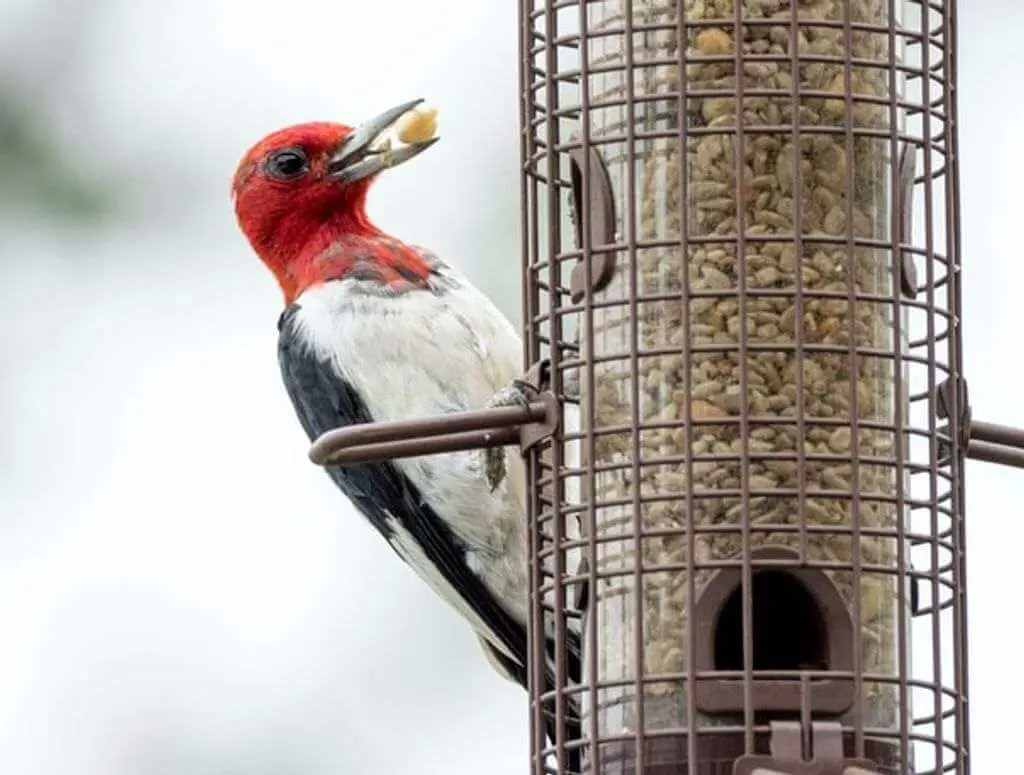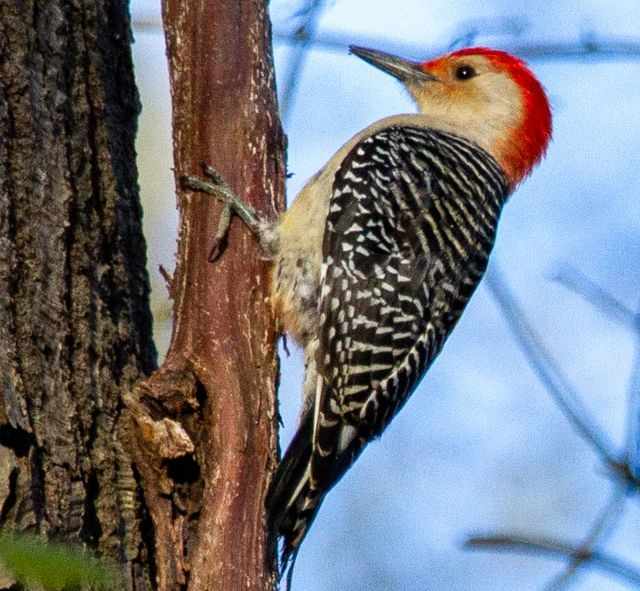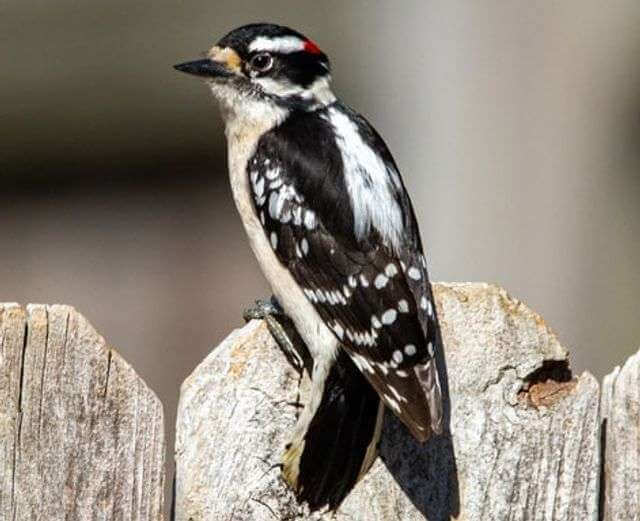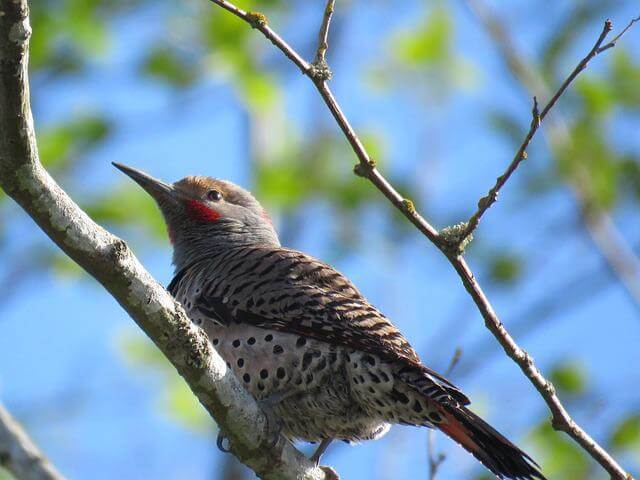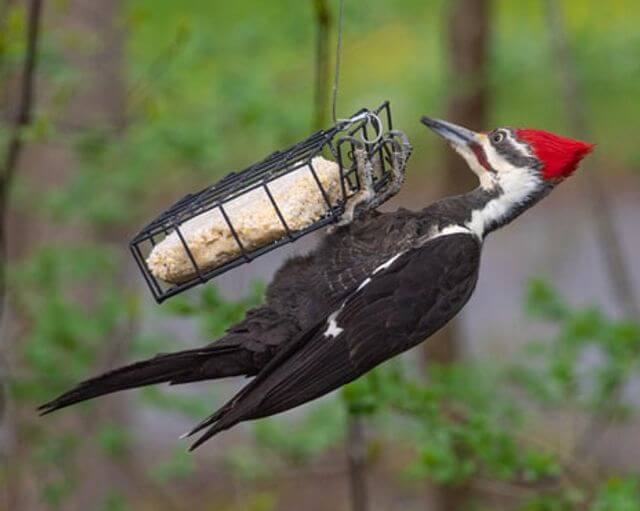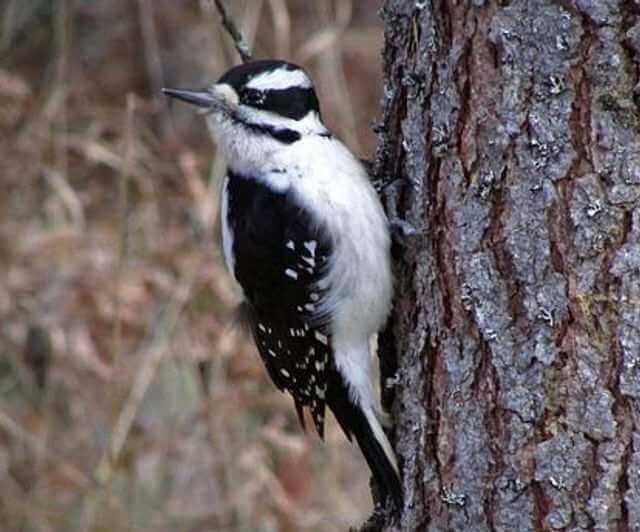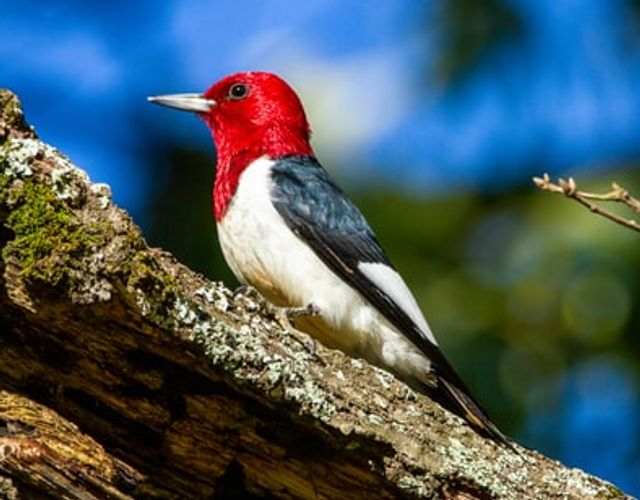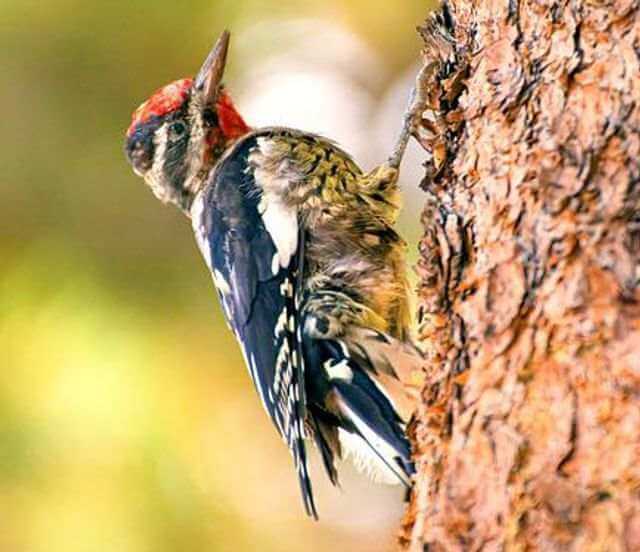Welcome to our comprehensive guide on the 9 types of woodpeckers found in Kentucky! Woodpeckers are captivating birds known for their drumming and pecking behaviors.
In this ultimate guide, we’ll delve into the various species of woodpeckers native to Kentucky, exploring their unique characteristics, habitats, and behaviors.
Whether you’re a birdwatcher, nature enthusiast, or simply intrigued by Kentucky’s wildlife, this guide is your ultimate resource for learning about these remarkable birds.
Table of Contents
Types of Woodpeckers in Kentucky
Red-bellied Woodpecker
- Length: 9.5 in (24 cm)
- Weight: 2.0-3.2 oz. (56-90 g)
- Wingspan: 13.0-16.5 in (33-42 cm)
- Scientific Name: Melanerpes carolinus
- Frequency of Occurrence: 39.66% (Statistic by: eBird)
- Where To Find Them: In Kentucky, they can be found in hardwood forests and bottomland forests. They are often seen along rivers and creeks. They eat insects and fruits. Red-bellied woodpeckers can be seen year-round in Kentucky.
- How to Attract: You can attract them byplanting trees that produce berries or nuts, or by putting up a feeder that offers bird food. You can also provide them with a water source by putting out a bird bath or fountain. Another thing you can do to attract Red-bellied Woodpeckers is make sure your yard has plenty of large trees. These birds like to nest in dead trees or in holes in living trees. If you don’t have any dead trees in your yard, you can always install a nesting box for them.
Description: Red-bellied Woodpeckers are found in eastern North America, from southern Canada to Florida and west to Texas. They live in a variety of habitats, from the edges of forests to open fields and suburbs. These woodpeckers eat insects, fruits, and seeds.
They nest in trees, digging a hole in the trunk or a branch. The female lays 4-5 eggs and incubates them for about two weeks. The young birds stay in the nest for another two weeks before fledging.
Related Post: How to Attract Red-bellied Woodpeckers to your Yard?
Downy Woodpecker
- Length: 5.5-6.7 in (14-17 cm)
- Weight: 0.7-1.0 oz. (21-28 g)
- Wingspan: 9.8-11.8 in (25-30 cm)
- Scientific Name: Picoides pubescens
- Frequency of Occurrence: 37.25%
- Where To Find Them: Downy Woodpeckers can be seen in Kentucky at various locations throughout the state. Some good places to see them are in the Daniel Boone National Forest, Mammoth Cave National Park, Red River Gorge Geological Area, Cumberland Falls State Resort Park, and Barren River Lake State Resort Park.
- How to Attract: Downy Woodpeckers eat insects, so you can provide them with a feeding station that has a mix of insect-based foods such as suet, mealworms, and bird seed. You can also hang fruit or nut feeders in your yard. Another way to attract Downy Woodpeckers is to provide them with a place to nest. You can do this by putting up a bird house or by creating a dead tree stump for them to use as a roosting spot.
Description: The Downy Woodpecker (Picoides pubescens) is a small woodpecker that ranges throughout most of North America. They inhabit a wide variety of habitats, including forests, woodlands, and even parks or gardens. Downy Woodpeckers primarily eat insects, but they will also consume berries, nuts, and seeds.
They nest in tree cavities, either natural or excavated by the birds themselves. Downy Woodpeckers are common and widespread, making them one of the most easily-identified woodpeckers in North America.
Related Post: How to Attract Downy Woodpeckers to Your Yard? (Easy!)
Northern Flicker
- Length: 11.0-12.0 in (28-31 cm)
- Weight: 3.9-5.6 oz. (110-160 g)
- Wingspan: 16.5-20.0 in (42-51 cm)
- Scientific Name: Colaptes auratus
- Frequency of Occurrence: 16.68%
- Where To Find Them: Northern flickers can be seen in all parts of the state, but some of the best places to see them include: Cumberland Gap National Historical Park, Oldham County Park, Fort Boonesborough State Park, and Paintsville Lake State Park.
- How To Attract: Northern Flickers love insects, so make sure to provide plenty of food for them by planting insect-rich plants in your yard. Offer them a variety of food options, including seeds, nuts, and fruit. Place a bird feeder in your yard and fill it with different types of bird food. Provide a source of water for the birds by installing a bird bath or fountain. Keep your yard clean and free of debris so the birds have a safe place to forage and play.
Description: The Northern flicker is a medium-sized woodpecker found in North America and parts of Mexico. Northern flickers can be found in a variety of habitats, from forests to open fields, but they prefer to live in areas with plenty of large trees.
These birds eat mainly insects, but will also eat fruit, seeds, and nuts. Northern flickers build their nests in tree cavities or other sheltered locations. They typically lay 4-7 eggs and the chicks stay with the parents for about 2 months.
Related Post: How to Attract Northern Flickers to your Backyard (Easy)
Pileated Woodpecker
- Length: 15.8-19.3 in (40-49 cm)
- Weight: 8.8-12.3 oz. (250-350 g)
- Wingspan: 26.0-29.5 in (66-75 cm)
- Scientific Name: Dryocopus pileatus
- Frequency of Occurrence: 13.31%
- Where To Find Them: In Kentucky, they can be found in the eastern and southern parts of the state. Some areas to see them include: The Nature Conservancy’s Carden Cloudland Preserve, The Daniel Boone National Forest, The Red River Gorge Geological Area, and Big South Fork National River and Recreation Area.
- How To Attract: First, provide them with a food source. Insects are their primary food source, so offer them a bird feeder filled with insect-rich food. You can also place a log or two in your yard for them to search for insects. Second, provide them with a place to live. Pileated woodpeckers need large trees for nesting and roosting. If you have some large trees in your yard, they may be attracted to your property. You can also install a nest box if you don’t have any large trees.
Description: The Pileated Woodpecker is found in North America, extending from southern Canada to northern Mexico. They inhabit deciduous and mixed forests, as well as woodlands near streams and rivers. These woodpeckers are omnivorous, eating insects, nuts, seeds, fruits, and carrion.
They nest in cavities in trees, often using abandoned woodpecker holes. The female lays 3-6 eggs, which the male incubates for about two weeks. The young are altricial and stay with the parents for several months.
Related Post: How to Attract Pileated Woodpeckers to your Yard (Fast)
Hairy Woodpecker
- Length: 7.1-10.2 in (18-26 cm)
- Weight: 1.4-3.4 oz. (40-95 g)
- Wingspan: 13.0-16.1 in (33-41 cm)
- Scientific Name: Picoides villosus
- Frequency of Occurrence: 7.33%
- Where To Find Them: Some areas within Kentucky where you are likely to see them are: the Daniel Boone National Forest, the Big South Fork National River and Recreation Area, and the Mammoth Cave National Park.
- How To Attract: Hairy woodpeckers like to eat insects, so you can put out a bird feeder that has insect-rich food. You can also plant trees and shrubs that have insect-eating leaves, such as oak trees or black cherry trees. Another thing you can do is provide them with a water source.
Description: The Hairy Woodpecker is a medium-sized woodpecker that ranges from 7-10″ inches in length and weighs between 1.5-3.5 ounces. They can be found in forests across much of North America, parts of Central America, and northern South America.
Their habitats include coniferous, mixed, and deciduous forests. Hairy Woodpeckers feed on a variety of insects, including ants, termites, beetles, and caterpillars. They also consume fruit and nuts. These woodpeckers typically nest in tree cavities, but they will also use abandoned woodpecker holes or man-made nest boxes.
Red-headed Woodpecker
- Length: 7.5-9.1 in (19-23 cm)
- Weight: 2.0-3.2 oz. (56-91 g)
- Wingspan: 16.5 in (42 cm)
- Scientific Name: Melanerpes erythrocephalus
- Frequency of Occurrence: 5.16%
- Where To Find Them: Red-headed Woodpeckers can be seen throughout Kentucky, but some of the best places to see them include the Daniel Boone National Forest, the Land Between the Lakes National Recreation Area, and Grayson Lake State Park.
- How to Attract: One way to attract red-headed woodpeckers is to put out a bird feeder. They will eat a variety of food, so make sure to include both suet and seeds in your offerings. You can also provide them with a source of water by putting out a bird bath.
Description: Red-headed Woodpeckers are found in eastern North America, from southern Canada to Florida and west to Texas. They live in a variety of habitats, including woodlands, forests, parks, and suburbs. Red-headed Woodpeckers live in a variety of habitats, including woodlands, forests, parks, and suburbs.
They prefer to live in areas with large trees that have plenty of dead branches on which they can find food. The diet of the Red-headed Woodpecker consists mainly of insects. They also eat acorns, nuts, berries, and other fruit. They sometimes catch small vertebrates such as lizards or mice. The Red-headed Woodpecker nests in tree cavities.
Related Post: Interesting Red-Headed Woodpecker Facts (Explained)
Yellow-bellied Sapsucker
- Length: 7.1-8.7 in (18-22 cm)
- Weight: 1.5-1.9 oz. (43-55 g)
- Wingspan: 13.4-15.8 in (34-40 cm)
- Frequency of Occurrence: 3.42%
- Where To Find Them: The best place to see these birds in Kentucky is probably the Daniel Boone National Forest. This forest is located in the eastern part of the state, and it has a wide variety of habitats that are home to many bird species. Other good places to see Yellow-bellied Sapsuckers include Pine Mountain State Park and Red River Gorge.
- How to Attract: Plant trees and shrubs that produce sap, such as maples, birches, and mountain ashes. Leave dead tree branches standing in your yard; sapsuckers love to drill into the soft wood for insects. Hang suet feeders filled with fat or peanut butter; sapsuckers love these high-fat foods. Provide a source of water, such as a birdbath or pond; sapsuckers often drink from open water sources.
Description: The yellow-bellied sapsucker is a North American woodpecker that ranges from southern Canada to central Mexico. They inhabit deciduous and mixed forests, as well as wooded suburbs and parks. These birds are mostly insectivorous, but also eat fruit and seeds.
Yellow-bellied sapsuckers nest in tree cavities, either natural or excavated by the birds themselves. The female lays 3-8 eggs, which are incubated for about two weeks. Both parents help feed the young, which fledge after about two months.
Related Post: 16 Interesting Sapsucker Facts Revealed!
Red-cockaded Woodpecker
- Length: 7.9-9.1 in (20-23 cm)
- Weight: 1.5-1.8 oz. (42-52 g)
- Wingspan: 14.2 in (36 cm)
- Scientific Name: Picoides borealis
- Frequency of Occurrence: 0.0016%
- Where To Find Them: There are several areas within the state where you can see these beautiful birds, including the Daniel Boone National Forest and the Clifty Falls State Park.
- How to Attract: You can provide food for red-cockaded woodpeckers by putting out bird feeders filled with suet, peanuts, or seeds. You can also provide them with dead trees or logs that have been left to decay naturally. These logs provide the birds with a place to roost and nest, as well as a place to find food.
Description: The red-cockaded woodpecker is a federally endangered bird that can be found in the southeastern United States. These birds typically inhabit pine forests and use their long, pointed beaks to extract insects from the bark of trees. Unlike most woodpeckers, red-cockaded woodpeckers do not build nests in tree cavities but instead lay their eggs on pine needles or in small cups made of chewed bark.
These birds are omnivorous and eat both insects and fruit. They also consume sap from pine trees, which is thought to help them digest insects more easily. Red-cockaded woodpeckers mate for life and both parents help incubate the eggs and care for the young.
Ivory-billed Woodpecker
- Length: 18.1-20.1 in (46-51 cm)
- Weight: 15.9-20.1 oz (450-570 g)
- Wingspan: 29.9-31.5 in (76-80 cm)
- Scientific Name: Campephilus principalis
- Frequency of Occurrence: 0.0000%
- Where To Find Them: There are several areas within the state where you may be able to see this bird, including the Daniel Boone National Forest, Cumberland Gap National Historical Park, and Land Between the Lakes National Recreation Area. The best time of year to see them is during the spring and fall migration periods.
- How to Attract: Provide a large, dead tree or other structure for them to nest in. Install a bird feeder and fill it with suet, nuts, or seeds. Keep your yard free of pesticides and chemicals. Make sure there is sufficient water available so they can drink.
Description: The ivory-billed woodpecker is a very large woodpecker that is found in the southeastern United States. The bird’s range once extended from Florida to eastern Texas, but it is now considered to be very rare and its range has been reduced to a few small areas in Arkansas and Louisiana. The ivory-billed woodpecker inhabits bottomland forests and swamps. It feeds on insects, nuts, and fruit.
The bird nests in tree cavities, often using abandoned nests of other birds. Ivory-billed woodpeckers were once common throughout the eastern United States, but their population declined steadily in the 20th century. By the early 21st century, they were considered extinct in the US. However, there have been some sightings of ivory-billed woodpeckers in Arkansas and Louisiana since 2004.
Related Post: Most Common Backyard Birds in Kentucky (Explained)

